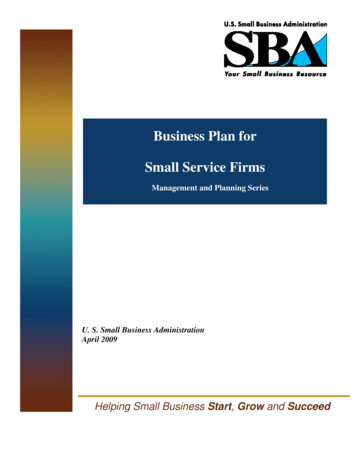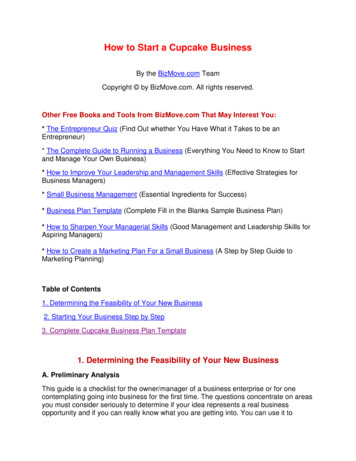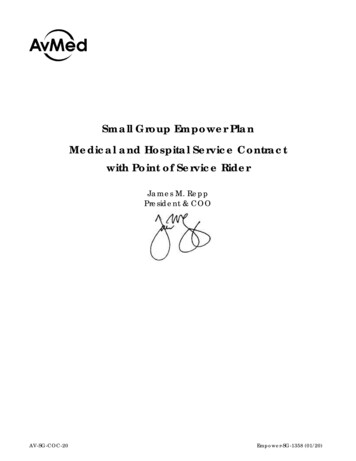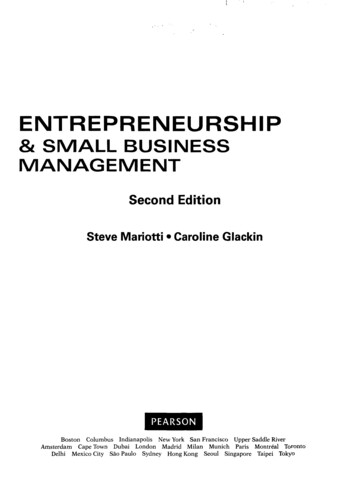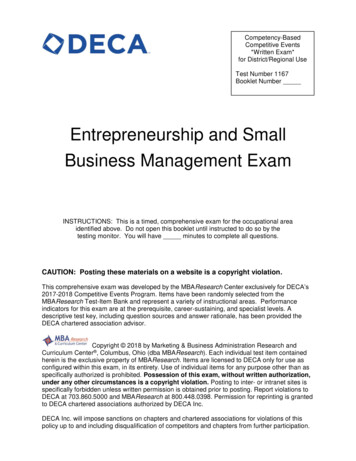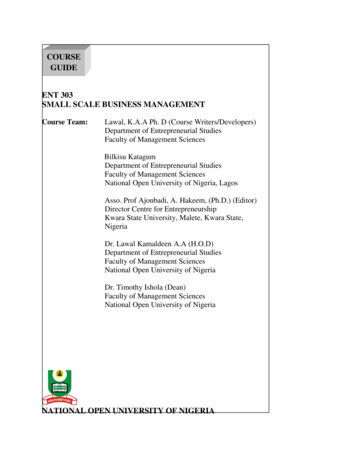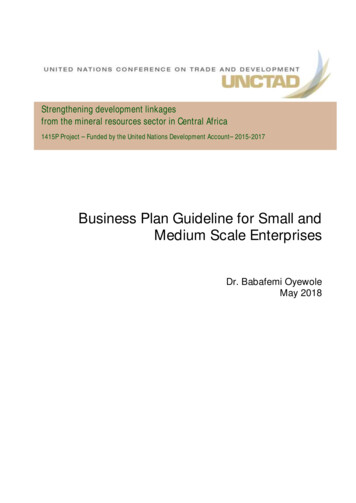
Transcription
Strengthening development linkagesfrom the mineral resources sector in Central Africa1415P Project Funded by the United Nations Development Account 2015-2017Business Plan Guideline for Small andMedium Scale EnterprisesDr. Babafemi OyewoleMay 2018
BUSINESS PLAN GUIDELINE FOR SMALLAND MEDIUM SCALE ENTERPRISESbyDr. Babafemi Oyewole (Consultant)May 2018Geneva, 2018ii
AcknowledgementsUNCTAD commissioned a business plan guideline for small and medium scale enterprises in the oil,gas and mining sector as part of United Nations Development Account Project 1415P:"Strengthening the capacity of the Economic Community of Central African States to enhancedevelopment linkages".The paper was written, by a consultant, Dr. Babafemi Oyewole, Managing Director of EnergySynergy Partners. The paper was reviewed by Mr. Rachid Amui, Economic Affairs Officer, under theoverall guidance and supervision of Ms. Yanchun Zhang, Chief, Commodity Policy Implementationand Outreach Section (CPIOS), Commodities Branch of the Division of International Trade andCommodities.While due care was taken in compiling this report, any errors and omissions remain the author'sresponsibility.DisclaimerThe material in this paper represents the personal views of the author only, and not the views ofthe UNCTAD secretariat or its member States. This is an unedited publication.The designations employed, and the presentation of the material do not imply the expression of anyopinion on the part of the United Nations concerning the legal status of any country, territory, cityor area, or of authorities, or concerning the delimitation of its frontiers or boundaries.NoteMaterial in this publication may be freely quoted or reprinted, but acknowledgement is requested,together with a copy of the publication containing the quotation or reprint to be sent to the UNCTADsecretariat.ContactsFor further information, please contact us at:UNCTADCommodities BranchPalais des Nations8–14, Avenue de la Paix1211 Geneva 10SwitzerlandPhone: 41 22 917 1648 / 6286E-mail: i
BUSINESS PLAN GUIDELINE FOR SMALL AND MEDIUM SCALE ENTERPRISESTable of contentAcknowledgements . iii1. Introduction . 12. The Objective and Principles for Preparing a Business Plan . 12.1 The Objectives of a Business Plan . 12.2 General Principles for Developing a Business Plan . 23. The Structure of a Business Plan. 23.1 Executive Summary . 23.2 The Business . 33.2.1 Business Overview . 33.2.2 Business Goals and Objectives . 43.2.3 Business Strategy and Key Success Factors. . 53.2.4 Organization, Ownership and Management . 53.3 Operational Plan . 63.4. Industry and Market Analysis . 63.4.1 Industry analysis . 63.4.2 Market Analysis . 83.4.3 Marketing Strategy . 83.4.3 Product Analysis . 83.5 Financial Statements and Projections . 93.5.1 Income Statement . 93.5.2 Assumptions for financial projections . 133.5.3 Financial Ratios . 133.5.4 Financing method . 14Concluding remarks . 14References. 15
BUSINESS PLAN GUIDELINE FOR SMALL AND MEDIUM SCALE ENTERPRISES1. IntroductionThis paper develops a framework or guideline for the preparation of business plans for small andmedium enterprises (SMEs) to enable them take advantage of opportunities for local contentdevelopment in the oil, gas and mining sector. It presents the essential elements and methodologiesof writing business plans for SMEs aspiring to engage in industry participation in the oil and gasindustry. The guide is for SMEs that have put in place basic organizational structures for thebusiness. If they can develop a good business plan, it could assist them in raising the needed capitalfor implementing contracts and projects in the sector. The paper is divided into three parts includingthis introduction which forms part one. Part two considers the purpose of a business plan and thegeneral principles for preparing it while part three presents the structure of the business plan tohelp the enterprises construct effective business plans.2. The Objective and Principles for Preparing a Business Plan2.1 The Objectives of a Business PlanThere are two primary purposes for preparing a business plan. The first is external, to secure fundingthat is very important for the growth and development of the enterprise. The second is internal,which is to support the strategic and corporate development of the business. In this regard, it is alsouseful for setting the strategic direction for the organization and its decision makers to achieve itsobjectives within the time frame of the plan which could be two to three years. A good businessplan also provides the organization with an operational framework that could give it a competitiveadvantage in the industry by serving as:a) Action Plan in the short term by breaking down the complex tasks of starting a business into manysmaller and less cumbersome tasks, each of which is assigned a due date, person (s) responsible,and detailed action plans for achieving them. For existing businesses, it enables greater focus ondealing with issues in an organized, coherent and systematic manner.b) Roadmap for the medium to long term because once the business has started, a business plancan be an invaluable tool to help managers keep on track and moving in the direction set for theorganization. Without a plan, it is very easy to lose focus in running of day-to-day operations of thebusiness and also help others to understand the vision of the enterprise. It serves as the roadmapto achieving the objectives of the organization.c) Performance Tool, a business plan serves as a performance tool because it is an operationalinstrument which, when properly used, will help the management of the enterprise to set realisticgoals and objectives for performance as well as providing a basis for evaluating and controlling thefuture performance of the organization.d) Business Promotion Tool, a business plan is a business promotion and marketing tool which oftenassists the management of the enterprise to persuade investors and lenders to provide financialsupport for its activities. The business plan enables them to understand the current activities andfuture direction of the organization and the goals, objectives and strategies developed to achieveperformance.1
BUSINESS PLAN GUIDELINE FOR SMALL AND MEDIUM SCALE ENTERPRISES2.2 General Principles for Developing a Business PlanThere are some basic principles or guidelines that should be followed in the preparation of abusiness plan and it covers the basic elements of the plan. These will be useful in writing a businessplan for any audience. These are:1. Easy to Read: The business plan must be well prepared for easy understanding. Theintroductory statement is the most important part because it summarizes your business in oneor two pages. The plan must be written in a very simple language so that it can be understoodwhen people read it.2. Market Analysis: The market to be served is more important than the product that will beoffered because investors or customers are primarily interested in how the market will reactand receive the products and services. The plan should demonstrate and substantiate researchon how customers will benefit from the products and service or what is called “WIIFT” (What’sIn It For Them).3. Distribution Plan: Be specific about the strategies that will be used to sell and distributeproducts or services, clearly outlining the methods and the cost of getting the products orservices to the ultimate customers. This will include logistics, warehousing and deliveryarrangements.4. Business Uniqueness and Competitive Advantages: This should be highlighted and shouldexplain what will give your business a competitive advantage in the marketplace. For example,you can state any special attributes, like patents, copyrights, strategic partners or newtechnologies of the company.5. Management: The strength of the organization’s management in terms of experience,professional qualifications and achievements should be emphasized in the business plan. It isalso important to mention the policies put in place to keep them and that directors andmanagement possess the necessary credibility to run the business.6. Projections: Projections on future activities and performance indicators should be realistic,credible and substantiated with plausible assumptions that can be validated.7. End user in focus: Business plans should be designed with the end user in mind. Banker’s orfinancier’s look for stability, security, cash flow coverage, and sound returns, whereas a VentureCapitalist is more interested in high leverage resulting in high returns. Therefore, the uses offunds should show that funds invested are adequately secured and cash flows will more thancover their interest and principal payments.3. The Structure of a Business PlanThe business plan follows a similar structure whatever the size of the organization. The basicelements of a business plan are presented below:3.1 Executive SummaryThe executive summary gives an overview of the business plan. It should not be more than twopages and contains all the highlights of the plan that will provide a strong impact to readers becauseit may be the first thing investors or stakeholders see about the business. In the summary, the planshould be condensed, interesting and present the business in its best form because it could be usedas an extract for those who are less interested in the details of the business or who want to analysean aspect of the business. In preparing the summary, the following questions should be answered: What sort of business is it?2
BUSINESS PLAN GUIDELINE FOR SMALL AND MEDIUM SCALE ENTERPRISES What is the product/service and why is it special? Who are the managers? How much money do you need? When, and at what stage would it be required? What will you use it for?The summary should capture the readers’ initial interest and encourage them to desire to knowmore about the business. Overall, the executive summary provides an assessment of: a) TheBusiness, b) Products/Services, c) Industry Analysis and Trends, d) Competition, e) Strategic Position,f) Marketing Plan, g) Income and Assets summary and h) Use of Proceeds Summary (where fundsare borrowed).3.2 The Business3.2.1 Business OverviewThis part of the plan describes the business, its vision, mission, values, goals, objectives andcorporate strategies. It will also highlight the strategic initiatives and milestones of the business aswell as the competitive advantage it has over existing competitors. It is here that you build a pictureof the business as follows:Figure 1: Building blocks of a good ion3.2.1.1 The Vision StatementThe vision statement is a precise, well-drafted statement indicating the direction of the business. Itis an inspiring short and succinct statement of what the business intends to become and to achievein the future often stated in competitive terms. It describes the aspirations for the future, withoutspecifying the means that will be used to achieve those desired outcomes and serves as the coreideals that remains steady and provide guidance in decision making. Examples of vision statementare: General Electric (GE): “We bring good things to life”Apple: “To change the world through technology”Ford Motor Company: “To become the world’s leading consumer company for automotiveproducts and services”3.2.1.2 The Mission StatementThis is a broad statement of the purpose of the business, specifying its fundamental raison d’être. Itpresents the purpose and long-term aspirations and gives a justification for the business as well asdefines the core activities and the strategic goals, objectives and priorities of the business in a very3
BUSINESS PLAN GUIDELINE FOR SMALL AND MEDIUM SCALE ENTERPRISESconcise manner. The purpose of the mission statement is to affirm the long-term commitment toachieving its vision, and serves as reminder to the top management about the purpose of thebusiness, where it is going and what it needs to get there as well as giving the employees a cleardirection and challenge to achieve the mission and motivates them by giving them a sense ofpurpose in being part of the business. The mission statement enables the business to communicateits purpose to both insiders and outsiders. For example, the mission statement of Shell PetroleumCompany is: “Our mission is to search for oil and produce, refine and market petroleum andpetroleum products throughout the world”. The statement captures the company’s core businessactivities, including its target market and the products and services it offers.3.2.1.3 Corporate ValuesThese are values that reflect the core ideology of a business entity and are independent of currentindustry environment, product life cycle and management trends. They are immutable event if theindustry changes. The following are examples of values that some businesses have adopted: Excellent customer service Continuous improvement Pioneering technology Creativity andinnovation Human resource development Integrity Empathy. An example of vision, missionand value statement is presented below:Vision, Mission and shared Value Statements of Nigerian National Petroleum Company (NNPC).Vision: “NNPC will be a world-class oil and gas company driven by shared commitment toexcellence”.Mission: “NNPC is an integrated Oil and Gas Company, engaged in adding value to the nation’shydrocarbon resources for the benefit of all Nigerians and other stakeholders”.Core values: Respect for the individualStaff development and growthIntegrity, transparency and accountabilityProfessional Excellence3.2.2 Business Goals and Objectives3.2.2.1 GoalsThese are broad business results that the business is absolutely committed to achieving and aretypically stated in terms of general business intentions such as “becoming the market leader” or“being a low-cost provider of choice”. Goals provide the link between the mission of the businessand its actions and it will ultimately dictate the choices made by the organization.3.2.2.2 ObjectivesThese are specific steps, milestones, which enable the business to accomplish its goals. Theobjectives must be result-driven and not action-driven. It should be SMART: Specific, Measurable,Attainable, Reasonable and Timely. Setting objectives inculcate a sense of direction amongemployees and facilitate coordinated growth across the business entity. They also act as abenchmark against which actual performance can be evaluated and guide decision-making andaction by the management. Objectives are different from goals because they are quantifiable unlikegoals that are generalized open-ended statements of desired outcomes without quantification ortime specific.4
BUSINESS PLAN GUIDELINE FOR SMALL AND MEDIUM SCALE ENTERPRISES3.2.3 Business Strategy and Key Success Factors.3.2.3.1 Business StrategyThis relates to the strategic initiatives the business plan to undertake in order to achieve its vision,mission, goals and objectives. It involves the entire organization and covers the range and depth ofits core activities and the relationship with its environment. It addresses a business’s basic directionfor the future: its purpose, its ambitions, its resources, and how it interacts with the industry and,more importantly, towards other competing businesses in the marketplace. Business strategy is aninstrument by the organization to gain a sustainable advantage over its competitors and concernsitself with the survival of the business as a minimum objective and added value as a maximumobjective.3.2.3.2 Key Success Factors (KSFs)These are the fundamental issues that must be available for the business to compete effectively inthe market place. The factors should specific and they include the followings:(i)Adopting new technologies(ii) Hiring human resources(iii) Strategic location(iv) Distribution channels and marketing strategies(v) Government regulation(vi) Improving services or customer focus(vii) Enhancing operations towards best practice3.2.4 Organization, Ownership and Management3.2.4.1 Organizational Structure:The organization of the business around its activities is very important because it is essentiallydeveloped to deliver the vision and mission of the business. It is represented by the organizationalchart which helps to explain the communicate, operational processes, reporting lines, and thelinking mechanisms between the roles and responsibilities. It illustrates to all the communicationlines, how the control system operates and who is in control, who has authority and finally, who isresponsible. organizational structure may be hierarchical reflecting communication flowing fromtop management to the units down the entity. Modern organizations tend to be horizontal, betweenindividuals and departments, rather than the upwards or downwards flow used by conventionalstructures which tends to be bureaucratic. A simplified organizational chart is presented below:Figure 2: A Model Matrix Organizational ChartManagerDepartment ADepartment BDepartment C5Department D
BUSINESS PLAN GUIDELINE FOR SMALL AND MEDIUM SCALE ENTERPRISESThis type of structure is often referred to as the matrix structure and it has the advantage of beingcross-functional while maintaining functions and the commitment and specialization of individualdepartments. It also allows for flexibility for change, encourages commitment to the business as awhole, improves the communication among its different units.3.2.4.2 Ownership and ManagementThe business plan must indicate the ownership and management structure of the business. Theinformation that should be incorporated into the plan includes the names of owners, percentageownership, relationship with the business, forms of ownership. The top management cadre of thebusiness must also be presented in the business plan because it constitutes one of the key successfactors in any business. The names, position, primary responsibilities, education, experience andskills, past employment and track records, industry recognition and compensation levels and basismust be indicated in the management sector of the business plan.3.3 Operational PlanThe operational plan provides guidance to employees and ensures smooth process flow in thebusiness. It describes the role of each department in the organization and has the benefit ofimproving the overall morale and commitment among all employees involved in the plan becauseit gives them a clearer understanding of their roles and functions. It also allows the lower levelemployees to highlight the daily operational inefficiencies and bottlenecks that top managementmay not be able to see and it provides a basis for control and performance appraisal and enablesjunior employees to gain valuable experience that will help them to assume higher futureresponsibilities in the organization.3.4. Industry and Market Analysis3.4.1 Industry analysisThis involves analyzing the environment in which the business operates in order to identify theforces in the industry that must be recognized, plan for and deal with in order to be successful. Anindustry analysis questionnaire is usual prepared as a guide to an effective and result-orientedanalysis of the industry. A sample of the questionnaire is presented below:Table 1: An example of Industry analysis questionnaire.Number of competitors are:ManyModerateFew?Are the numbers of competitors increasing?YesNo-?Is your industry dominated by a few players?YesNo-?Do new technologies affect your products and services?YesNo-?Is there a large and untapped market that your industrycan expand to?YesNo-?Does price play an important role?YesNo-?Do consumers’ tastes change frequently?YesNo-?Are there substitutes for your products and services?YesNo-?Barriers of entry to your business are.HighModerateLow?Powers of distributors are.HighModerateLow?Bargaining power of customers are.HighModerateLow?Powers of suppliers are.HighModerateLow?6
BUSINESS PLAN GUIDELINE FOR SMALL AND MEDIUM SCALE ENTERPRISESNumber of competitors are:ManyModerateFew?Is your revenue.GrowingStableDeclining?Profit margins are.GrowingStableDeclining?Costs within your industry are.GrowingStableDeclining?Source: IFAC, 2006.The technique that is frequently used in presenting industry analysis is known as SWOT analysis. Itinvolves the process of scanning the internal and external environment of the organization, whichis an important part of the planning process. Environmental factors internal to the entity are usuallyclassified as Strengths or Weaknesses and those external to the organization are classified asOpportunities or Threats. A SWOT analysis is a useful way of looking at the current and future statusof the business. It provides information that is helpful in matching the resources of the businessand capabilities to the competitive environment. The chart 1 below illustrates how SWOT analysisfits into an industry analysis:Chart 1: Components of SWOT analysisSTRENGTHSWEAKNESSES Economies of scale Lack of marketing expertise Specialist marketing expertise Undifferentiated products and service (i.e. in relation toyour competitors) Exclusive access to natural resources Patents New, innovative product or service Strategic location Cost advantages through proprietary know-how Strong distribution networks Strong brand names with solid reputation Poor location of your business Weak distribution channels Poor quality goods or services Weak brand name and reputation in market Lack of patent protection High cost structureOPPORTUNITIESTHREATS Developing and expanding your market A new competitor in your home market Mergers, joint ventures or strategic alliances Price war Moving into new attractive market segments Competitor has a new, innovative substitute product orservice A new-found market Loosening of rules and regulations Removal of international trade barriers A market led by a weak competitor New regulations Increased trade barriers Taxation may be introduced on your product or service Unfulfilled needs and wants New technologiesSource: Ibid, op.cit.The strength of the business are its resources and capabilities that can serve as a basis for developinga competitive advantage and the plan must be based on the strengths. Weaknesses are issues thatcan weaken the ability of the business to compete in the market and they must be identified, studiedand rectified to ensure that they did not occur in the future. Opportunities are the avenues in the7
BUSINESS PLAN GUIDELINE FOR SMALL AND MEDIUM SCALE ENTERPRISESexternal environment for business and profit making while threats are factors that can hinder thebusiness of the organization.3.4.2 Market AnalysisThis involves the analysis of the group of customers that the business is targeting to serve with itsproducts or services and the identification of the specific target market. One method of marketanalysis is market segmentation which is the identification of specific groups of customers whorespond differently from other groups to competitive strategies because could be more profitableand attractive, have more competition, growing faster and offer more development opportunitiesthan others. A careful analysis of segments and their characteristics is therefore very important inidentifying who buys the products or services, what they buy, where they buy and when they buy.3.4.3 Marketing StrategyIn the business plan, the marketing strategy to get the products or services should be well outlined.The approach that is usually employed is the 4Ps of marketing strategy which provides informationabout 1) Product – anything that is offered to a market to satisfy a want or need. 2) Price – howmuch is charged for your products or services. 3) Promotion – a means of bringing the product tothe marketplace. 4) Place (distribution) – a means of bringing the product to the marketplace.3.4.3 Product AnalysisThere is also the need to analyze the products of the business to determine market share and marketgrowth rate. The tool employed for this analysis is the Boston Consulting Group (BCG) GrowthShare Matrix which is made up of four quadrants that describe the products in relation to marketshare and market growth rate. The matrix illustrates the product’s life cycle and position in themarket by charting each product in one of the four quadrants as shown below:Market GrowthHighStars(Cash Neutral)Question Marks(Cash User)Cash Cow(Cash Generator)Dogs(Cash Neutral)LowHighLowMarket ShareSource: Philip Kotler (2003).The Matrix serves as a decision-making framework for allocating resources between the variousbusiness units and allows the comparison of each product performance. Resources are allocated to8
BUSINESS PLAN GUIDELINE FOR SMALL AND MEDIUM SCALE ENTERPRISESbusiness units in relation to their position on the grid as follows: a) Cash cow – a business unit orproduct with a large market share in a mature, slow growing industry. Cash cows require littleinvestment and generate cash for investment in other business units. b) Star – a unit or product thathas large market share in a fast-growing industry. Though stars could generate cash, but it needsinvestment to sustain the lead, and could eventually become a cash cow when the industry reachesmaturity. c) Question mark is a business unit that has a small market share in a high growth marketand they require resources to grow market share, but the success of investment is not predictableor potentially unlikely and d) Dog – a business unit that has a small market share in a matureindustry, though not requiring large amounts of investment, it could tie down capital that could bebetter used in other units or products.3.5 Financial Statements and ProjectionsThis is the part of the business plan that determines whether the business idea is viable and is a keycomponent in determining whether the plan is going be attractive to investors and financiers. Itrepresents the future of the business based on a set of assumptions about the economy, marketgrowth and other factors captured in the swot analysis carried out in the previous section. Thefinancial projections must be substantiated and not to make the figures look attractive. It consistsof three financial statements – the income statement, cash flow statement, and the balance sheet,and a brief explanation/analysis of these statements.3.5.1 Income StatementThe income statement shows the revenues, expenses and profits for a particular period. It is asnapshot of your business that shows whether the business is profitable at that point in time;revenue – expenses profit or loss. An example of an income statement is presented in table 2.Table 2: Hypothetical Projected Income Statement for XYZ Company.2017FORECAST RevenueGross salesSales returns and allowancesNet RevenueLess Cost of Goods SoldOpening Inventory – Finished GoodsCost of materials ConsumedOpening Inventory – Raw MaterialsPurchasesFreight2018PROJECTION 2019PROJECTION 006,573,840(15,870)6,557,970-342,100422,558Closing Inventory – Raw MaterialsCost of Materials ConsumedDirect LabourUtilities & other direct costsFactory overhead costDepreciationCost of Goods Manufactured for saleClosing inventory – finished goodsCost of good
BUSINESS PLAN GUIDELINE FOR SMALL AND MEDIUM SCALE ENTERPRISES 1 1. Introduction This paper develops a framework or guideline for the preparation of business plans for small and medium enterprises (SMEs) to enable them take advantage of opportunities for loc
